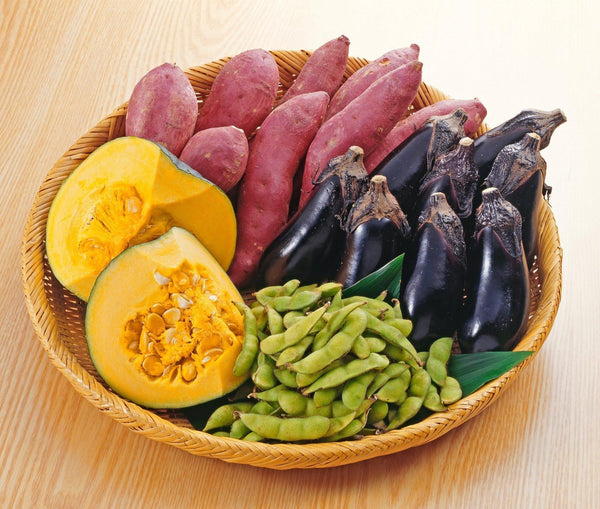
Jump to:
If you’ve ever wandered into a Japanese grocery store, you may have noticed that the selection of vegetables is very different from what you’d find in Western countries. Japan has a rich tradition of making use of seasonal fruits and vegetables in everything from home-cooked dishes to kaiseki fine dining experiences.
Despite incorporating fresh and flavorful vegetables in their cuisine, many of these veggies are not well-known outside of Japan. In this article, we'll introduce you to 20 of the most popular Japanese vegetables that you might want to add to your diet. From kabocha to renkon, you’ll learn what these vegetables are so that you can experiment with new recipes and discover their unique flavors!
Shiso

Shiso is a herb that is commonly used in Japanese cuisine and is a member of the mint family. It has quite a distinctive flavor that could be described as a mix of basil, cinnamon, mint, and anise, and can be considered an acquired taste.
Green shiso leaves are often used as a garnish or seasoning, whilst red shiso leaves are primarily to add color and flavor to pickled vegetables.
How to use: Try using shiso as a garnish or topping in your cooking to bring some color and aroma to your dishes. You can also add it to sushi, onigiri, or pair it with fish dishes.
Nasu (Japanese Eggplant)

Whilst eggplant is not a veggie that is unfamiliar to Western palates, there are some differences between the nasu (Japanese eggplant) and other types. Japanese eggplants are sweeter and milder in flavor than other varieties, with a long slender shape and dark purple skin.
The sweetness of the nasu makes it a popular ingredient in Japanese cooking and features in well-known dishes such as nasu dengaku – grilled eggplant with a miso sauce.
Nasu is also a popular tempura item and is very versatile when it comes to cooking as it can be grilled, steamed, roasted, or fried.
How to use: You can add nasu to almost any dish – for Japanese cuisine try making your own nasu dengaku or you can add it to pasta and stir-fries.
Shishito Peppers

These small green peppers are usually pan-fried or grilled until the skin is slightly charred and are used in a variety of dishes including tempura and yakitori. In tempura, the peppers are dipped in a light batter and fried until crispy. In yakitori, they are skewered and grilled with a savory soy-based sauce. Whilst most shishito peppers are not spicy, occasionally you’ll find a spicy one in a bunch which can come as a bit of a surprise!
How to use: Try serving grilled shishito peppers as a healthy appetizer with a dipping sauce or adding them to a stir fry or salad.
Mitsuba

Similar to parsley, mitsuba is a Japanese herb that grows in wooded areas and whose flavor could be described as a mix of celery and cilantro, and it’s a popular and versatile garnish found in soups, salads, and noodle dishes.
The name mitsuba means ‘three leaves’ in Japanese and in addition to being high in vitamins, its health benefits are said to include improving blood circulation and reducing stress.
How to use: Try adding mitsuba to miso soup, Japanese hotpot, or to sushi rolls.
Daikon

Daikon is a kind of Japanese radish that can be eaten raw or cooked. A long and white vegetable, they can grow to be quite large, up to one or two feet in length! It has a crunchy texture and peppery taste. Daikon is low in calories and carbohydrates, and packed full of vitamins and nutrients including folate, making it a recommended vegetable for pregnant women.
Daikon can be grated for use as a garnish for savory dishes and is a popular vegetable for pickling within Japanese cuisine.
How to use: Pickle daikon for a tasty side dish or add to soups, salads, or hot pot dishes like oden.
Komatsuna

Komatsuna is a kind of leafy green Japanese vegetable also known as mustard spinach. It is similar to pak choi and is often used as an ingredient in stir fry dishes. It’s also used in a popular Japanese spinach side dish called ohitashi, which refers to vegetables steeped in a dashi-based sauce.
Healthwise, komatsuna is rich in nutrients including calcium and vitamins A and C, which are important for healthy vision, skin, and immune function. Komatsuna is even said to be a good vegetable to eat for its superb anti-aging effects.
How to use: You can add komatsuna to many kinds of dishes to add color, texture, and flavor. Try using it in stir-fries, hotpot, or as a filling in omelets or okonomiyaki.
Takenoko

These Japanese bamboo shoots are a popular ingredient in Japanese cooking, either as a standalone side dish or an ingredient in other dishes such as stir-fries, rice dishes, soups, and sukiyaki. A popular dish since Edo times, takenoko have a firm and crispy texture and are sweet in taste.
Takenoko are mostly cultivated during the months of April and May, making digging for bamboo shoots a popular springtime activity in more rural areas of Japan. It is also a popular Japanese sansai vegetable.
How to use: Try making Takenoko Gohan (bamboo rice), a popular dish which consists of savory rice mixed with crunchy bamboo shoots in a dashi broth.
Gobo

Gobo is the Japanese for burdock root, a long, slender root vegetable that looks a bit like a tree root. It has a brownish-grey skin that is often peeled before use, revealing a white interior with a slightly sweet, earthy flavor. It is a good source of fiber and potassium and is known for its unique flavor and texture. It’s used mainly as an ingredient in simmered dishes, miso soup, and stir-fries.
How to use: One of the most popular dishes gobo is used for is called kinpira gobo, a stir fry dish consisting of sauteed gobo and carrots, which is cooked in a sweet soy sauce.
Mizuna

Mizuna is a leafy green vegetable that is commonly used in Japanese cuisine and is a member of the mustard family. It has a slightly peppery, mild flavor and long, slender leaves that are dark green in color. It is a fast-growing plant that is typically harvested when it is young and tender, before the leaves become tough and bitter.
Mizuna is a good source of antioxidants, and in Japanese cooking, mizuna is often used in salads, stir-fries, and soups.
How to use: Eat mizuna raw by adding it to salads or cook it as part of a hotpot meal.
Myoga

Myoga is a kind of Japanese ginger that has a unique tangy flavor. Its taste is more subtle than other kinds of ginger and is often used as a condiment or a seasoning in Japanese dishes. It’s believed to have anti-inflammatory and antioxidant properties and is a good source of vitamin C.
Myoga is often used in Japanese cuisine in pickled dishes known as tsukemono or as a topping for salads or noodle dishes.
How to use: The easiest way to use myoga is as a garnish in salads.
Yamaimo

Yamaimo, also known as Japanese mountain yam, is a type of yam that is commonly used in Japanese cuisine and is high in fiber. It has a long, cylindrical shape and brown, rough skin that is peeled off before consuming. The flesh of yamaimo is white and slimy when grated, and it is often eaten raw – cut into thin strips or grated.
How to use: Add grated yamaimo to miso soup or over soba noodles.
Konnyaku

Konnyaku is a Japanese vegetable made from the bulb of the konjac plant that is high in water and fiber, and low in calories. The dietary fiber in konnyaku called glucomannan expands when it is mixed with water, so it promotes a feeling of fullness when eaten, making it a popular diet food.
Konnyaku has been part of the Japanese diet for many years and is used in stir-fries, salads, and side dishes.
How to use: Try using konnyaku noodles instead of pasta or noodle soup dishes for a healthier alternative. You can also add it as an ingredient to Japanese hotpot dishes like nabe, oden, and sukiyaki.
Edamame

Edamame is more than just a tasty bar snack - they're a versatile and nutritious addition to a variety of dishes. These young, green soybeans have a unique flavor that's reminiscent of peas, but with a firmer texture that's satisfying to bite into. Whether you enjoy them straight from the pod as an appetizer or add them to stir-fried dishes and salads, edamame are a colorful and flavorful way to boost the nutritional value of your meals.
One of the great things about edamame is its impressive nutritional profile. These little beans are packed with protein, folate, and vitamin K, making them a smart choice for anyone looking to increase their intake of these important nutrients. And because they're so versatile, it's easy to incorporate edamame into your diet in a way that works for you - whether you're looking for a quick and healthy snack or a protein-packed addition to your favorite dishes.
How to use: Eat raw edamame as a tasty snack or add the shelled beans to salads or rice dishes like risotto.
Kabocha

Kabocha is a kind of Japanese winter squash that has a green skin and orange flesh. It has a taste reminiscent of sweet potato or butternut squash and was first introduced to Japan in the 19th century from the US.
Aside from its delicious taste, kabocha is also packed with nutrients. It's an excellent source of iron, vitamin C, and potassium, making it a smart choice for anyone looking to boost their intake of these important vitamins and minerals.
Whether you roast it, mash it, or use it in a soup or stew, kabocha is a versatile and nutritious addition to any meal.
How to use: Try adding kabocha as an ingredient to katsu curry and rice, miso soup, or tempura!
Satsumaimo

Satsumaimo is a kind of Japanese sweet potato that has a reddish-purple skin and pale flesh and has a long and slender shape. It's often used in Japanese cuisine to make desserts, such as sweet potato cakes or pies, as well as in savory dishes like tempura or stews. Because of its sweet flavor, satsumaimo is also commonly eaten as a snack, either roasted or boiled and topped with a sprinkle of salt. Satsumaimo is also a rich source of vitamins and minerals. It's high in dietary fiber, vitamin C, and potassium. You can read more about satsumaimo in this article.
How to use: Try eating baked satsumaimo by steaming or microwaving it, a simple yet tasty way to enjoy this popular vegetable.
Hakusai

This versatile Japanese cabbage is a key ingredient in many of Japan's most beloved dishes, from comforting nabe hotpot to crispy cabbage rolls and savory gyoza fillings. With its green and white leaves, hakusai not only adds color and texture to these dishes, but also a range of health benefits.
Hakusai is naturally low in calories and high in water content, making it a smart choice for anyone looking to maintain a healthy diet. It's also packed with vitamin C, which is believed to be especially important during the winter months for boosting immunity and warding off colds and flu. It's also a key ingredient in Korean kimchi, a spicy fermented vegetable dish known for its probiotic benefits and gut-healthy properties.
How to use: Try adding hakusai to your stir-fry dishes or making yummy stuffed cabbage rolls.
Naganegi

Naganegi is a type of long onion that is commonly used in Japanese cuisine. It looks similar to a leek but with a thinner stem and a more delicate flavor. Naganegi is an important ingredient in many Japanese dishes, particularly in soups, stews, and hotpots.
The long, slender shape of naganegi makes it ideal for cutting into thin slices, which can be used to add a subtle onion flavor and texture to a wide range of dishes. It's also a popular choice for making negi miso, a type of miso soup that features chopped naganegi and other savory ingredients.
How to use: Try making delicious yakitori skewers with chicken and naganegi.
Renkon

Renkon is a Japanese lotus root that is a common ingredient used in nimono – Japanese simmered dishes. It has a pale color, unique hole-shaped appearance, and a crunchy texture. It's a key ingredient in kinpira renkon, a traditional Japanese dish made by stir-frying sliced lotus root with soy sauce, sugar, and other seasonings. Nutrition-wise, renkon is a good source of vitamin C and fiber.
How to use: Try adding renkon to salads, stir-fries, or pop it in your air fryer to make crispy baked renkon chips!
Moyashi

Moyashi are young and tender bean sprouts and a popular ingredient in Japanese cuisine. These crunchy sprouts add a refreshing flavor to dishes and are commonly used in salads, stir-fries, and soups. They are also an excellent way to add some extra texture and nutrition to your meals.
Moyashi can be used to bulk up your meals easily and affordably while adding a healthy dose of vitamin C, iron, and folate to your diet. Typically made from mung beans or soybeans, moyashi are a low-calorie food that can help you feel fuller for longer.
How to use: Try adding moyashi to salads, ramen, in okonomiyaki, or inside spring rolls for an added sweet and crunchy element.
Goya

This Okinawan green superfood is also known as ‘bitter melon’ in English and has the appearance of a long bumpy cucumber-shaped vegetable. Its taste is very bitter which can make it a little challenging to eat, with many people either loving or hating it.
If you can learn to love goya, the health benefits are impressive, including lowering blood sugar levels, increasing metabolism, stimulating digestion, and fighting cancer cells.
How to use: Try adding a small amount of goya to stir fries to become accustomed to the strong taste. Once you are used to the taste, you can add it to more dishes and healthy green juices.
Nozawana

This crisp Japanese leafy green originates from Nagano Prefecture and is known for its mild flavor and firm, crunchy texture. Nozawana looks similar to a long, thick-stemmed mustard green and is most famous for being preserved as pickles called nozawana-zuke. Unlike stronger leafy greens, its taste is mellow with a pleasant earthy note, making it easy to enjoy in many dishes.
Nozawana is rich in vitamins A, C, and K, as well as minerals like calcium and iron. It supports digestion, boosts immunity, and provides antioxidants that help protect cells from damage.
How to use: Add chopped nozawana pickles to rice bowls, fried rice, ochazuke, or onigiri. Fresh nozawana can be sautéed lightly with soy sauce or used in stir-fries. You can also enjoy it as a simple side dish or mix it into noodle dishes for added crunch and flavor.
What’s your favorite Japanese vegetable? Let us know in the comments!


0 comments